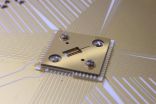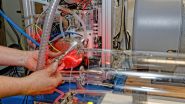Squeezed quantum cats
2015-05-26
(Press-News.org) This news release is available in German.
Quantum physics is full of fascinating phenomena. Take, for instance, the cat from the famous thought experiment by the physicist Erwin Schrodinger. The cat can be dead and alive at once, since its life depends on the quantum mechanically determined state of a radioactively decaying atom which, in turn, releases toxic gas into the cat's cage. As long as one hasn't measured the state of the atom, one knows nothing about the poor cat's health either - atom and kitty are intimately "entangled" with each other.
Equally striking, if less well known, are the so-called squeezed quantum states: Normally, Heisenberg's uncertainty principle means that one cannot measure the values of certain pairs of physical quantities, such as the position and velocity of a quantum particle, with arbitrary precision. Nevertheless, nature allows a barter trade: If the particle has been appropriately prepared, then one of the quantities can be measured a little more exactly if one is willing to accept a less precise knowledge of the other quantity. In this case the preparation of the particle is known as "squeezing" because the uncertainty in one variable is reduced (squeezed).
Schrödinger's cat and squeezed quantum states are both important physical phenomena that lie at the heart of promising technologies of the future. Researchers at the ETH were now able successfully to combine both in a single experiment.
Squeezing and shifting
In their laboratory, Jonathan Home, professor of experimental quantum optics and photonics, and his colleagues catch a single electrically charged calcium ion in a tiny cage made of electric fields. Using laser beams they cool the ion down until it hardly moves inside the cage. Now the researchers reach into their bag of tricks: they "squeeze" the state of motion of the ion by shining laser light on it and by skilfully using the spontaneous decay of its energy states. Eventually the ion's wave function (which corresponds to the probability of finding it at a certain point in space) is literally squashed: now the physicists have a better idea of where the ion is located in space, but the uncertainty in its velocity has increased proportionately. "This state squeezing is an important tool for us", Jonathan Home explains. "Together with a second tool - the so-called state-dependent forces - we are now able to produce a "squeezed Schrödinger cat" ".
To that end the ion is once more exposed to laser beams that move it to the left or to the right. The direction of the forces induced by the laser depends on the internal energy state of the ion. This energy state can be represented by an arrow pointing up or down, also called a spin. If the ion is in an energy superposition state composed of "spin up" and "spin down", the force acts both to the left and to the right. In this way, a peculiar situation is created that is similar to Schrödinger's cat: the ion now finds itself in a hybrid state of being on the right (cat is alive) and on the left (cat is dead) at the same time. Only when one measures the spin does the ion decide whether to be on the right or on the left.
Stable cats for quantum computers
The Schrödinger cat prepared by professor Home and his collaborators is special in that the initial squeezing makes the ion states "left" and "right" particularly easy to distinguish. At the same time, it is also pretty large as the two ion states are far apart. "Even without the squeezing our "cat" is the largest one produced to date", Home points out. "With the squeezing, the states "left" and "right" are even more distinguishable - they are as much as sixty times narrower than the separation between them". All this isn't just about scientific records, however, but also about practical applications. Squeezed Schrödinger cats are particularly stable against certain types of disturbances that would normally cause the cats to lose their quantum properties and become ordinary felines. That stability could, for instance, be exploited in order to realize quantum computers, which use quantum superposition states to do their calculations. Furthermore, ultra-precise measurements could be made less sensitive to unwanted external influences.
INFORMATION:
Literature reference
Lo HY, Kienzler D, de Clercq L, Marinelli M, Negnevitsky V, Keitch, BC, Home JP: Spin-motion entanglement and state diagnosis with squeezed oscillator wavepackets. Nature, 21 May 2015, doi: 10.1038/nature14458 [http://dx.doi.org/10.1038/nature14458]
[Attachments] See images for this press release:

ELSE PRESS RELEASES FROM THIS DATE:
2015-05-26
This news release is available in German.
Leipzig / Helsinki. A first global scale study has estimated how forest emitted compounds affecting cloud seeds via formation of low-volatility vapours. According to the latest projections, terrestrial vegetation emits several million tons of extremely low-volatility organic compounds (ELVOCs) per year to the atmosphere. These oxidation products of compounds such as monoterpenes results in an increase of condensing vapours that can further form cloud condensation nuclei over the continents and thus has an influence ...
2015-05-26
Montréal, May 25, 2015 - A team of researchers at the IRCM led by François Robert, PhD, uncovered a critical role for two proteins in chromatin structure. Their breakthrough, recently published in the scientific journal Molecular Cell, helps explain how DNA is organized in our cells. This discovery could lead to a better understanding of what causes certain types of cancer, such as lymphoma.
Dr. Robert and his team study chromatin, the structure composed of DNA and proteins that makes up chromosomes. Its main role is to package DNA molecules containing all the ...
2015-05-26
LOS ANGELES (May 26, 2015) - Biomedical researchers at Cedars-Sinai have invented a tiny drug-delivery system that can identify cancer cell types in the brain through "virtual biopsies" and then attack the molecular structure of the disease.
If laboratory research with mice is borne out in human studies, the results could be used to deliver nano-scale drugs that can distinguish and fight tumor cells in the brain without resorting to surgery.
"Our nanodrug can be engineered to carry a variety of drugs, proteins and genetic materials to attack tumors on several fronts ...
2015-05-26
Queen's University PhD student Matt Shultz is researching magnetic, massive stars, and his research has uncovered questions concerning the behaviour of plasma within their magnetospheres.
Drawing upon the extensive dataset assembled by the international Magnetism in Massive Stars (MiMeS) collaboration, led by Mr. Shultz's supervisor, Queen's professor Gregg Wade, along with some of his own observations collected with both the Canada-France-Hawaii Telescope and the European Southern Observatory's Very Large Telescope, Mr. Shultz is conducting the first systematic population ...
2015-05-26
Washington, D.C. -- May 26, 2015 -- A new study has demonstrated that a protein called Niemann-Pick C1 (NPC1) is critical for the Ebola virus to infect a host. The study, published in the May/June issue of mBio, the online open-access journal of the American Society for Microbiology, suggests that drugs that block NPC1 could be used to treat this deadly disease.
"The science behind the concept of blocking the interaction between NPC1 and the virus is solid. Now, it is just a matter of powering through and identifying drugs that can inhibit NPC1 and moving them forward," ...
2015-05-26
An international team including scientists from Albert Einstein College of Medicine of Yeshiva University and the U.S. Army Medical Research Institute of Infectious Diseases (USAMRIID) has identified the molecular "lock" that the deadly Ebola virus must pick to gain entry to cells. The findings, made in mice, suggest that drugs blocking entry to this lock could protect against Ebola infection. The study was published in today's edition of the online journal mBio.
The researchers found that the Ebola virus can't infect cells unless it first attaches to a host protein called ...
2015-05-26
By unlocking the secrets of a bizarre virus that survives in nearly boiling acid, scientists at the University of Virginia School of Medicine have found a blueprint for battling human disease using DNA clad in near-indestructible armor.
"What's interesting and unusual is being able to see how proteins and DNA can be put together in a way that's absolutely stable under the harshest conditions imaginable," said Edward H. Egelman, PhD, of the UVA Department of Biochemistry and Molecular Genetics. "We've discovered what appears to be a basic mechanism of resistance - to ...
2015-05-26
Mitsuyoshi Nakao, Director of the Institute of Molecular Embryology and Genetics in Kumamoto University and Associate Professor Noriko Saitoh revealed that a cluster of defined, non-coding RNAs are mechanistically involved in endocrine therapy resistance in human breast cancer cells. Furthermore, resveratrol, a kind of polyphenol, was found to repress these RNAs and inhibit the proliferative activity of breast cancer cells which had acquired resistance. The work was published in Nature Communications on April 29th, 2015.
Breast cancer is one of the most common types ...
2015-05-26
This news release is available in French.
Commuting length, distance, and means are stress factors that can lead to burnout, says Annie Barreck of the University of Montreal's School of Industrial Relations. "A correlation exists between commuting stress factors and the likelihood of suffering from burnout. But their importance varies according to the individual, the conditions in which their trips take place, and the place where the individual works," she explained. Barreck will present her research today at the 83rd congress of the Association francophone pour ...
2015-05-26
In a new national survey of rheumatoid arthritis (RA) patients, Health Union found a severe impact on quality of life, employment, and ability to afford treatment. The autoimmune condition attacks the body, resulting in joint inflammation, pain, stiffness, and swelling, but may also harm other organs. About 1.3 million Americans or about one percent of the global population have RA.
Ninety-four percent of respondents with RA said they cannot do as much as they were able before acquiring the disease. Additionally, 67% said others do not understand the severity of their ...
LAST 30 PRESS RELEASES:
[Press-News.org] Squeezed quantum cats



